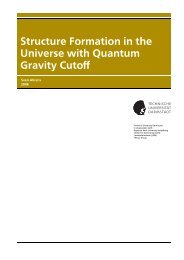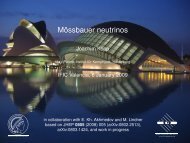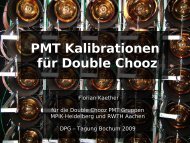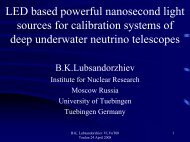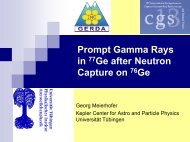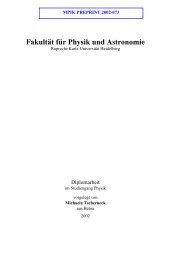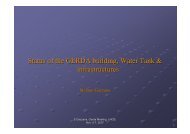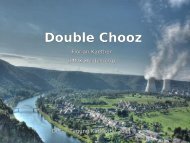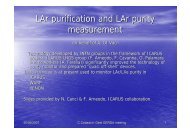Natural convection in enclosures with localized heating from below ...
Natural convection in enclosures with localized heating from below ...
Natural convection in enclosures with localized heating from below ...
You also want an ePaper? Increase the reach of your titles
YUMPU automatically turns print PDFs into web optimized ePapers that Google loves.
HFF<br />
10,5<br />
518<br />
Received November 1999<br />
Revised May 2000<br />
Accepted May 2000<br />
International Journal of Numerical<br />
Methods for Heat & Fluid Flow,<br />
Vol. 10 No. 5, 2000, pp. 518-529.<br />
# MCB University Press, 0961-5539<br />
The current issue and full text archive of this journal is available at<br />
http://www.emerald-library.com<br />
<strong>Natural</strong><strong>convection</strong><strong>in</strong><strong>enclosures</strong><br />
<strong>with</strong> <strong>localized</strong> heat<strong>in</strong>g <strong>from</strong><br />
<strong>below</strong> and symmetrical cool<strong>in</strong>g<br />
<strong>from</strong> sides<br />
Orhan Ayd<strong>in</strong> and Wen-Jei Yang<br />
Department of Mechanical Eng<strong>in</strong>eer<strong>in</strong>g and Applied Mechanics,<br />
University of Michigan, Ann Arbor, Michigan, USA<br />
Keywords <strong>Natural</strong> <strong>convection</strong>, Enclosures<br />
Abstract <strong>Natural</strong> <strong>convection</strong> of air <strong>in</strong> a two-dimensional, rectangular enclosure <strong>with</strong> <strong>localized</strong><br />
heat<strong>in</strong>g <strong>from</strong> <strong>below</strong> and symmetrical cool<strong>in</strong>g <strong>from</strong> the sides has been numerically <strong>in</strong>vestigated.<br />
Localized heat<strong>in</strong>g is simulated by a centrally located heat source on the bottom wall, and four<br />
different values of the dimensionless heat source length, 1/5, 2/5, 3/5 and 4/5 are considered.<br />
Solutions are obta<strong>in</strong>ed for Rayleigh number values <strong>from</strong> 10 3 to 10 6 .Local results are presented <strong>in</strong><br />
the form of streaml<strong>in</strong>e and isotherm plots as well as the variation of local Nusselt number on the<br />
heated wall.F<strong>in</strong>ally, the average Nusselt number at the heated part of the lower wall, Nu, was<br />
shown to <strong>in</strong>crease <strong>with</strong> an <strong>in</strong>crease the Rayleigh number, Ra, or of the nondimensional heat<br />
source thickness, .<br />
Nomenclature<br />
g = gravitational acceleration, m/s 2<br />
Gr = Grashof number, dimensionless<br />
H = height of the enclosure, m<br />
l = length of the heat source, m<br />
L = length of the enclosure, m<br />
n = coord<strong>in</strong>ate <strong>in</strong> normal direction<br />
Nu = Nusselt number, dimensionless<br />
Pr = Prandtl number, dimensionless<br />
Ra = Rayleigh number, dimensionless<br />
T = temperature, K<br />
t = time, s<br />
u = velocity component <strong>in</strong> x-direction, m/s<br />
U = nondimensional velocity component <strong>in</strong><br />
x-direction<br />
v = velocity component <strong>in</strong> y-direction, m/s<br />
V = nondimensional velocity component <strong>in</strong><br />
y-direction<br />
x, y = coord<strong>in</strong>ates def<strong>in</strong>ed <strong>in</strong> Figure 1<br />
X,Y = nondimensional coord<strong>in</strong>ates<br />
Greek symbols<br />
= thermal diffusivity, m 2 /s<br />
= thermal expansion coefficient, 1/K<br />
= vorticity, 1/s<br />
= nondimensional temperature<br />
= nondimensional vorticity<br />
= nondimensional time<br />
= stream function, m 2 /s<br />
= nondimensional stream function<br />
= nondimensional length of the heat<br />
source<br />
= generalized nondimensional variable<br />
Subscripts<br />
C = cold wall<br />
H = hot wall<br />
i, j = coord<strong>in</strong>ate <strong>in</strong>dices<br />
wall = at wall<br />
x = <strong>in</strong> x-direction<br />
y = <strong>in</strong> y-direction<br />
Introduction<br />
The study of natural <strong>convection</strong> <strong>in</strong> <strong>enclosures</strong> provides a useful description of<br />
the conf<strong>in</strong>ed fluids <strong>in</strong> many practical situations. Most of the previous studies
have addressed natural <strong>convection</strong> <strong>in</strong> <strong>enclosures</strong> due to either a horizontally or<br />
vertically imposed temperature difference. However, departures <strong>from</strong> this basic<br />
situation are often encountered <strong>in</strong> such fields as the electronics cool<strong>in</strong>g. The<br />
cool<strong>in</strong>g of electronic components is essential for their reliable operation.<br />
<strong>Natural</strong> <strong>convection</strong> cool<strong>in</strong>g has been widely used because of its simplicity, low<br />
cost and reliability (Incropera, 1988; Peterson and Ortega, 1990; Kim and Lee,<br />
1996).<br />
Torrance et al. (1969) experimentally and Torrance and Rockett (1969)<br />
numerically studied the <strong>convection</strong> of air <strong>in</strong> a vertical cyl<strong>in</strong>drical enclosure,<br />
<strong>in</strong>duced by a small hot spot centrally located on the floor. Solutions were<br />
obta<strong>in</strong>ed for Grashof numbers <strong>from</strong> 4 10 4 to 4 10 10 . The theoretical results<br />
were found to be <strong>in</strong> an excellent agreement <strong>with</strong> the experimental ones <strong>in</strong> the<br />
lam<strong>in</strong>ar region. Chu et al. (1976) studied, both theoretically and experimentally,<br />
the effect of the size and location of an isothermal, horizontal strip <strong>in</strong> an<br />
otherwise <strong>in</strong>sulated vertical surface of a rectangular channel. For a similar<br />
cavity, Turner and Flack (1980) made an experimental study. The natural<br />
<strong>convection</strong> <strong>in</strong> an <strong>in</strong>cl<strong>in</strong>ed box <strong>with</strong> the half of the lower surface heated and the<br />
other half <strong>in</strong>sulated was <strong>in</strong>vestigated experimentally and numerically by Chao<br />
et al. (1983). The effects of elevation of the heated and <strong>in</strong>sulated segments were<br />
<strong>in</strong>vestigated, as well as of <strong>in</strong>cl<strong>in</strong>ation about the longer dimension. An<br />
experimental <strong>in</strong>vestigation was conducted by Kamotani et al. (1983) to study<br />
natural <strong>convection</strong> heat trasnfer <strong>in</strong> a water layer <strong>with</strong> <strong>localized</strong> heat<strong>in</strong>g <strong>from</strong><br />
<strong>below</strong>. The flows were driven by ma<strong>in</strong>ta<strong>in</strong><strong>in</strong>g a small circular heat source, at a<br />
uniform temperature. The flow structures and temperature fields were<br />
<strong>in</strong>vestigated <strong>in</strong> detail for various aspect ratios (depth/width) and Grashof<br />
numbers Gr. Steady natural <strong>convection</strong> <strong>in</strong> a square, water-filled enclosure<br />
heated <strong>from</strong> <strong>below</strong> and cooled on one vertical side is studied analytically and<br />
numerically by November and Nansteel (1987). Keyhani et al. (1988)<br />
<strong>in</strong>vestigated, both numerically and experimentally, natural <strong>convection</strong> <strong>in</strong> a<br />
vertical cavity <strong>with</strong> one isothermal vertical cold wall and three alternatively<br />
adiabatic and flush-heated sections of equal height on the opposite wall. A<br />
numerical <strong>in</strong>vestigation of natural <strong>convection</strong> of air <strong>in</strong> square cavities <strong>with</strong> halfactive<br />
and half-<strong>in</strong>sulated vertical wall was made by Valencia and Frederick<br />
(1989). An experimental and numerical study was made by Chu and Hichox<br />
(1990) for natural <strong>convection</strong> <strong>in</strong> an enclosure <strong>with</strong> <strong>localized</strong> heat<strong>in</strong>g <strong>from</strong> <strong>below</strong><br />
<strong>in</strong> order to simulate the convective transport <strong>in</strong> a magma chamber. The large<br />
viscosity variation characteristics of magma <strong>convection</strong> was simulated by<br />
us<strong>in</strong>g corn syrup as the work<strong>in</strong>g fluid. Hasnaoui et al. (1992) numerically<br />
<strong>in</strong>vestigated natural <strong>convection</strong> <strong>in</strong> an enclosure <strong>with</strong> <strong>localized</strong> heat<strong>in</strong>g <strong>from</strong><br />
<strong>below</strong>. The upper surface was cooled at a constant temperature and a portion of<br />
the bottom surface was isothermally heated while the rest of the bottom surface<br />
and vertical walls were adiabatic. The existence of multiple steady-state<br />
solutions and the oscillatory behavior for a given set of the govern<strong>in</strong>g<br />
parameters were demonstrated. Ganzorolli and Milanez (1995) numerically<br />
<strong>Natural</strong><br />
<strong>convection</strong> <strong>in</strong><br />
<strong>enclosures</strong><br />
519
HFF<br />
10,5<br />
520<br />
Figure 1.<br />
Geometry and boundary<br />
conditions of the<br />
problem<br />
analyzed steady natural <strong>convection</strong> <strong>in</strong> an enclosure heated <strong>from</strong> <strong>below</strong> and<br />
symmetrically cooled <strong>from</strong> the sides. The effects of the Rayleigh number, the<br />
Prandtl number and aspect ratio on the flow and energy transport were<br />
determ<strong>in</strong>ed. Ramos and Milanez (1998) performed an experimental and<br />
numerical analysis for natural <strong>convection</strong> flow caused by heat sources<br />
dissipat<strong>in</strong>g energy at a constant rate simulat<strong>in</strong>g electronic components<br />
mounted at the bottom surface of a cavity symmetrically cooled <strong>from</strong> the sides<br />
and <strong>in</strong>sulated at the top.<br />
In the present study, natural <strong>convection</strong> <strong>in</strong> a square enclosure <strong>with</strong> <strong>localized</strong><br />
heat<strong>in</strong>g <strong>from</strong> <strong>below</strong> and symmetrical cool<strong>in</strong>g <strong>from</strong> the sides is considered. As it<br />
appears <strong>from</strong> the exist<strong>in</strong>g literature, this study is the first attempt at study<strong>in</strong>g<br />
the natural <strong>convection</strong> phenomenon <strong>in</strong> an enclosure under the above mentioned<br />
thermal conditions. Symmetrical cool<strong>in</strong>g <strong>from</strong> the sides is expected to be an<br />
efficient cool<strong>in</strong>g option, while partial heat<strong>in</strong>g at the lower surface simulates the<br />
electronic components such as chips. S<strong>in</strong>ce natural <strong>convection</strong> flows <strong>in</strong><br />
<strong>enclosures</strong> arise <strong>in</strong> many eng<strong>in</strong>eer<strong>in</strong>g processes, the results to be obta<strong>in</strong>ed here<br />
may be applicable to other fields of <strong>in</strong>terest. The effects of the Rayleigh number<br />
and the nondimensional isothermal heat source length on the fluid flow and<br />
heat transfer are determ<strong>in</strong>ed. For = 0, which means that the whole part of the<br />
lower wall is heated, the boundary conditions applied here are identical to those<br />
considered by Ganzorolli and Milanez (1995).<br />
Analysis<br />
Consider the motion of a viscous fluid <strong>with</strong><strong>in</strong> a square enclosure <strong>with</strong> equal<br />
length and height, L=H, which is depicted <strong>in</strong> Figure 1. The size of the<br />
y<br />
T c<br />
x<br />
I<br />
T H<br />
adiabatic<br />
L<br />
adiabatic<br />
T c<br />
H
enclosure <strong>in</strong> z-direction is assumed to be <strong>in</strong>f<strong>in</strong>itely long. The lower wall has a<br />
centrally located heat source which is assumed to be isothermally heated at a<br />
constant temperature TH. The sidewalls are isothermally cooled at a constant<br />
temperature TC, while the bottom surface, except for the heated section, and the<br />
upper wall are considered to be adiabatic.<br />
Mathematical formulation<br />
The nondimensional set of the govern<strong>in</strong>g equations (stream function, vorticity<br />
and energy equations) for a two-dimensional, <strong>in</strong>compressible lam<strong>in</strong>ar flow <strong>with</strong><br />
constant fluid properties are given as (Ayd n et al., 1999a)<br />
@<br />
@<br />
@ 2<br />
@X<br />
@ @<br />
‡ U ‡ V<br />
@X @Y<br />
@<br />
@<br />
@2<br />
‡ ˆ …1†<br />
2 2<br />
@Y<br />
ˆ Pr @ 2<br />
@X<br />
2<br />
@ @<br />
‡ ‡ RaPr 2 @Y 2 @X<br />
@ @ @2 @2<br />
‡ U ‡ V ˆ ‡<br />
@X @Y 2<br />
@X @Y 2<br />
where the nondimensional parameters <strong>in</strong>clud<strong>in</strong>g stream function and vorticity<br />
are def<strong>in</strong>ed <strong>in</strong> the follow<strong>in</strong>g forms<br />
X ˆ x<br />
H<br />
Y ˆ y<br />
H<br />
ˆ<br />
U ˆ @<br />
@Y<br />
T TC<br />
TH T C<br />
V ˆ @<br />
@X<br />
ˆ t u<br />
U ˆ<br />
H 2 =H<br />
ˆ @V<br />
@X<br />
@U<br />
@Y<br />
…2†<br />
…3†<br />
V ˆ v<br />
=H …4†<br />
Appear<strong>in</strong>g <strong>in</strong> equation (3), Pr = = is the Prandtl number and Ra = g H 3 (T H ±<br />
T C)/ is the Rayleigh number.<br />
Boundary conditions<br />
Through the <strong>in</strong>troduction of the nondimensional parameters <strong>in</strong>to the physical<br />
boundary conditions illustrated <strong>in</strong> Figure 1, the follow<strong>in</strong>g nondimensional<br />
boundary conditions are obta<strong>in</strong>ed:<br />
ˆ 0 U ˆ V ˆ 0 at X ˆ 0; 1; 0 < Y < 1 …6†<br />
ˆ 1 U ˆ V ˆ 0 at Y ˆ 0;<br />
1<br />
2<br />
@<br />
1<br />
ˆ 0 U ˆ V ˆ 0 at Y ˆ 0; 0 < X <<br />
@Y 2<br />
X<br />
; 1 ‡<br />
2<br />
1 ‡<br />
2<br />
…5†<br />
…7†<br />
< X < 1 …8†<br />
<strong>Natural</strong><br />
<strong>convection</strong> <strong>in</strong><br />
<strong>enclosures</strong><br />
521
HFF<br />
10,5<br />
522<br />
@<br />
ˆ 0 U ˆ V ˆ 0 at Y ˆ 1; 0 < X < 1 …9†<br />
@Y<br />
For stream function, the boundary condition for entire surface of the enclosure<br />
is taken to be<br />
ˆ 0 …10†<br />
which implies that there is no mass transfer through the walls of the enclosure<br />
and that the boundaries themselves form one of the stream l<strong>in</strong>es.<br />
In general, the value of the vorticity on a solid boundary is deduced <strong>from</strong><br />
Taylor series expansion of the stream function around the solid po<strong>in</strong>t and<br />
can be expressed mathematically as<br />
wall ˆ @2<br />
@n2 …11†<br />
where wall is the value of the vorticity at wall and n is the outward drawn<br />
normal of the surface. In numerical calculations, the values of vorticity at<br />
corners are taken as averages of the values of vorticity at two neighbor<strong>in</strong>g<br />
nodes (Ayd n et al., 1999a).<br />
The average Nusselt numbers, Nu for the heated portion of the lower wall is<br />
given by<br />
Nu ˆ<br />
Z 1‡<br />
2<br />
where Nu(X) is the local Nusselt number and is given by<br />
1 2<br />
Nu…X† ˆ<br />
Nu…X†dX …12†<br />
@<br />
@Y Yˆ0<br />
…13†<br />
Numerical procedure<br />
The govern<strong>in</strong>g equations along <strong>with</strong> the boundary conditions are solved<br />
numerically, employ<strong>in</strong>g f<strong>in</strong>ite-difference techniques. The vorticity transport<br />
and energy equations are solved us<strong>in</strong>g the alternat<strong>in</strong>g direction implicit method<br />
of Peaceman and Rachford (Roache, 1982), and the stream function equation is<br />
solved by SOR (successive over-relaxation) method (Patankar, 1980). The overrelaxation<br />
parameter is chosen to be 1:8for stream function solutions. In order<br />
to avoid divergence <strong>in</strong> the solution of vorticity equation an under-relaxation<br />
parameter of 0.5 is employed. The buoyancy and diffusive terms are discretized<br />
by us<strong>in</strong>g central differenc<strong>in</strong>g while the use of hybrid differenc<strong>in</strong>g is preferred<br />
for convective terms for numerical stability. Start<strong>in</strong>g <strong>from</strong> arbitrarily specified<br />
<strong>in</strong>itial values of variables, the discretized transient equations are then solved by<br />
march<strong>in</strong>g <strong>in</strong> time until an asymptotic steady-state solution is reached.
Convergence of iteration for stream function solution is obta<strong>in</strong>ed at each time<br />
step. The follow<strong>in</strong>g criterion is employed to check for steady-state solution<br />
X<br />
i;j<br />
n‡1<br />
i;j<br />
n<br />
i;j ERMAX …14†<br />
where stands for , ,or ; n refers to time and i and j refer to space<br />
coord<strong>in</strong>ates. The value of ERMAX is chosen as 10 ±5 . The time step used <strong>in</strong> the<br />
computations is varied between 0:0001 and 0:001, depend<strong>in</strong>g on Rayleigh<br />
number and mesh size.<br />
A non-uniform mesh structure is employed, which is constructed us<strong>in</strong>g f<strong>in</strong>er<br />
grid spac<strong>in</strong>g near the walls and the mixed boundary po<strong>in</strong>ts for each case. The<br />
mesh structure is changed for each because of the shifted position of the<br />
mixed boundary po<strong>in</strong>ts. For each case, a mesh ref<strong>in</strong>ement study is conducted<br />
and f<strong>in</strong>ally the mesh structure on which f<strong>in</strong>er mesh ref<strong>in</strong>ement does not have a<br />
significant effect on the results is chosen and used for simulations. As an<br />
example, for = 1/5 at Ra =10 6 , it is observed that <strong>in</strong>creas<strong>in</strong>g the mesh size<br />
<strong>from</strong> 51 51 to 81 81 resulted <strong>in</strong> the changes of max and Nu by less than 1<br />
percent. Therefore, 51 51 mesh size is approved to be sufficient to resolve the<br />
velocity and temperature fields for the related case.<br />
The validity of the computer code developed has been already verified for<br />
the problem of natural <strong>convection</strong> <strong>in</strong> a square cavity hav<strong>in</strong>g differentially<br />
heated vertical walls and the problem of lam<strong>in</strong>ar natural <strong>convection</strong> <strong>in</strong> <strong>in</strong>cl<strong>in</strong>ed<br />
air layers heated <strong>from</strong> above (Ayd n et al., 1999a; 1999b).<br />
Results and discussion<br />
Flow fields, temperature fields, and heat transfer rates for various values of the<br />
Rayleigh number and the nondimensional size of the isothermal heat sources<br />
are exam<strong>in</strong>ed <strong>in</strong> this section. In order to simulate air cool<strong>in</strong>g of electronic<br />
components air is chosen as the work<strong>in</strong>g fluid (Pr = 0.71).<br />
The ma<strong>in</strong> characteristics of the natural <strong>convection</strong> flow and energy<br />
transport <strong>in</strong> an enclosure <strong>in</strong>clud<strong>in</strong>g a centrally located isothermal heat source<br />
are shown <strong>in</strong> Figure 2-5. Flow and temperature fields are shown <strong>in</strong> terms of<br />
streaml<strong>in</strong>es and isotherms, respectively. For each case, 20 equally spaced<br />
contours have been used to def<strong>in</strong>e the correspond<strong>in</strong>g structure. These figures<br />
show the effect of chang<strong>in</strong>g Rayleigh number for 10 3 Ra 10 6 and the effect<br />
of chang<strong>in</strong>g the dimensionless length of the heat source for = 1/5, 2/5, 3/5 and<br />
4/5. Ow<strong>in</strong>g to the symmetrical boundary conditions on the vertical walls, the<br />
flow and temperature fields are symmetrical about the mid-length of the<br />
enclosure. The symmetrical boundary conditions <strong>in</strong> the vertical direction result<br />
<strong>in</strong> a pair of counter-rotat<strong>in</strong>g cells <strong>in</strong> the left and right halves of the enclosure for<br />
all the parametric values considered. Ow<strong>in</strong>g to the symmetry, the flows <strong>in</strong> the<br />
left and right halves of the enclosure are identical except for the sense of<br />
rotation. Each cell ascends through the symmetry axis, then faces the upper<br />
<strong>Natural</strong><br />
<strong>convection</strong> <strong>in</strong><br />
<strong>enclosures</strong><br />
523
HFF<br />
10,5<br />
524<br />
Figure 2.<br />
Streaml<strong>in</strong>es and<br />
isotherms for = 1/5
<strong>Natural</strong><br />
<strong>convection</strong> <strong>in</strong><br />
<strong>enclosures</strong><br />
525<br />
Figure 3.<br />
Streaml<strong>in</strong>es and<br />
isotherms for = 4/5
HFF<br />
10,5<br />
526<br />
Figure 4.<br />
Variation of the local<br />
Nusselt number Nu at<br />
the heated wall for<br />
various Rayleigh<br />
numbers at = 2/5<br />
Figure 5.<br />
Variation of the average<br />
Nusselt number Nu at<br />
the heated wall <strong>with</strong> the<br />
Rayleigh number for<br />
various nondimensional<br />
heat source lengths,<br />
adiabatic wall through which it moves horizontally toward the correspond<strong>in</strong>g<br />
cold wall and f<strong>in</strong>ally it descends along the correspond<strong>in</strong>g cold wall under the<br />
effect of cool<strong>in</strong>g.<br />
Figure 2 illustrates the streaml<strong>in</strong>e and isotherm patterns obta<strong>in</strong>ed for = 1/5.<br />
For Ra =10 3 , the circulation <strong>in</strong>side the enclosure is so weak that the viscous
forces are dom<strong>in</strong>ant over the buoyancy force. As it can be seen <strong>from</strong> the figure,<br />
isotherms deviate slightly <strong>from</strong> a diagonally symmetric structure, which is the<br />
conduction solution (Ra = 0). This leads the conduction to be dom<strong>in</strong>ant heat<br />
transfer mechanism <strong>in</strong>side the enclosure. With <strong>in</strong>creas<strong>in</strong>g Rayleigh number, the<br />
<strong>in</strong>tensity of the recirculation <strong>in</strong>side the enclosure <strong>in</strong>creases and the cores of the<br />
cells move upward. At Ra =10 4 , isotherms deviates <strong>from</strong> the diagonally<br />
symmetric structure and conduction and advection modes of heat transfer are<br />
<strong>in</strong> a comparable level. Beyond Ra = 10 4 , the distortion of the isotherms<br />
<strong>in</strong>creases more and more and the advection takes the revenge, becom<strong>in</strong>g the<br />
dom<strong>in</strong>ant mode of heat transfer. At Ra = 10 5 , the formation of thermal<br />
boundary layers can be observed due to <strong>in</strong>creased recirculation <strong>in</strong>tensity. At Ra<br />
=10 6 , the thermal boundary layers become th<strong>in</strong>ner caus<strong>in</strong>g <strong>in</strong>creased energy<br />
transport. In addition, isotherms become stratified and the degree of<br />
stratification <strong>in</strong>creases <strong>with</strong> <strong>in</strong>creas<strong>in</strong>g Ra. Streaml<strong>in</strong>es and isotherms for =4/<br />
5 at different Rayleigh numbers are seen <strong>in</strong> Figure 3. The flow fields are nearly<br />
identical to those of = 1/5 for each Rayleigh number. However, the isotherms<br />
are effected by the <strong>in</strong>creas<strong>in</strong>g , as expected. S<strong>in</strong>ce the heated part of lower<br />
surface is larger than that of = 1/5, the heat<strong>in</strong>g effect at this case is much more<br />
sensible for the same values of Rayleigh numbers. For a fixed Ra, <strong>with</strong><br />
<strong>in</strong>creas<strong>in</strong>g , the flow field rema<strong>in</strong>s almost the same, while the temperature<br />
fields changes becom<strong>in</strong>g more stratified for larger values of Ra.<br />
Ow<strong>in</strong>g to the symmetry <strong>in</strong> the temperature field, heat transfer is<br />
L l<br />
symmetrical <strong>with</strong> respect to mid-length (x = L/2), hence Nu x ˆ 2 =<br />
Nu x ˆ L‡l<br />
2 . As an illustrative example, Figure 4 shows the variation of Nu<br />
along the heated part of the lower wall for = 2/5 for various Rayleigh<br />
numbers. The higher Ra means more heat <strong>in</strong>put, and as a result, more heat is<br />
added to the fluid to <strong>in</strong>tensify the fluid <strong>convection</strong>. The <strong>in</strong>tensified fluid<br />
<strong>convection</strong>, <strong>in</strong> turn, enables more heat to be received by the fluid pack through<br />
convective heat transfer. The most strik<strong>in</strong>g feature of this figure is the<br />
m<strong>in</strong>imum at heat transfer <strong>in</strong> X = 1/2. This m<strong>in</strong>imum orig<strong>in</strong>ates <strong>from</strong> the<br />
symmetrical boundary conditions applied <strong>in</strong> the vertical direction. The dualcell<br />
structure prohibits direct convective transfer between these two cells. Each<br />
cell behaves like an <strong>in</strong>sulator prevent<strong>in</strong>g the fluid pack <strong>from</strong> com<strong>in</strong>g <strong>in</strong>to<br />
contact <strong>with</strong> opposite cold wall.<br />
Plots of the average Nusselt number on the heated part of the lower wall as a<br />
function of Ra and are shown <strong>in</strong> Figure 5. For a fixed , <strong>in</strong>creas<strong>in</strong>g Ra<br />
enhances <strong>convection</strong>. In addition, <strong>in</strong>creas<strong>in</strong>g for a fixed Ra results <strong>in</strong> an<br />
<strong>in</strong>crease at Nu, which is more significant for high Ra values. These results can<br />
be clearly expla<strong>in</strong>ed under the views of the isotherms given <strong>in</strong> Figure 2 and 3.<br />
Conclusion<br />
In this <strong>in</strong>vestigation, the results of a numerical study of buoyancy-<strong>in</strong>duced flow<br />
and heat transfer <strong>in</strong> a two-dimensional square enclosure <strong>with</strong> <strong>localized</strong> heat<strong>in</strong>g<br />
<strong>from</strong> <strong>below</strong> and symmetrical cool<strong>in</strong>g <strong>from</strong> the sides are presented. The ma<strong>in</strong><br />
<strong>Natural</strong><br />
<strong>convection</strong> <strong>in</strong><br />
<strong>enclosures</strong><br />
527
HFF<br />
10,5<br />
528<br />
parameters of <strong>in</strong>terest are Rayleigh number and the dimensionless heat source<br />
length. The flow and temperature fields are symmetrical about the mid-length<br />
of the enclosure due to the symmetry of the boundary conditions <strong>in</strong> the vertical<br />
direction. For small Ra, the heat transfer is dom<strong>in</strong>ated by conduction across the<br />
fluid layer, while for high Ra the process is primarily one of <strong>convection</strong>, and the<br />
effect of conduction vanishes. Increas<strong>in</strong>g enhances the heat transfer, as<br />
expected, especially for high values of Rayleigh number.<br />
References<br />
Ayd n, O., UÈ nal, A. and Ayhan, T. (1999a), ``<strong>Natural</strong> <strong>convection</strong> <strong>in</strong> rectangular <strong>enclosures</strong> heated<br />
<strong>from</strong> one side and cooled <strong>from</strong> the ceil<strong>in</strong>g'', Int.J.Heat Mass Trans., Vol. 42, pp. 2345-55.<br />
Ayd n, O., UÈ nal, A. and Ayhan, T. (1999b), ``A numerical study on buoyancy-driven flow <strong>in</strong> an<br />
<strong>in</strong>cl<strong>in</strong>ed enclosure heated and cooled on adjacent walls'', Numer.Heat Trans.A, Vol. 36,<br />
pp. 585-9.<br />
Chao, P.K.-B., Ozoe, H., Churchill, S.W. and Lior, N. (1983), ``Lam<strong>in</strong>ar natural <strong>convection</strong> <strong>in</strong> an<br />
<strong>in</strong>cl<strong>in</strong>ed rectangular box <strong>with</strong> lower surface half-heated and half-<strong>in</strong>sulated'', J.Heat<br />
Transfer, Vol. 105, pp. 425-32.<br />
Chu, H.H.-S., Churchill, S.W. and Patterson, C.V.S. (1976), ``The effects of heater size, location,<br />
aspect ratio, and boundary conditions on two-dimensional, lam<strong>in</strong>ar, natural <strong>convection</strong><br />
channels'', J.Heat Transfer, Vol. 98, pp. 1194-201.<br />
Chu, T.Y. and Hichox, C.E. (1990), ``Thermal <strong>convection</strong> <strong>with</strong> large viscosity variation <strong>in</strong> an<br />
enclosure <strong>with</strong> <strong>localized</strong> heat<strong>in</strong>g'', J.Heat Transfer, Vol. 112, pp. 388-95.<br />
Ganzorolli, M.M. and Milanez, L.F. (1995), ``<strong>Natural</strong> <strong>convection</strong> <strong>in</strong> rectangular <strong>enclosures</strong> heated<br />
<strong>from</strong> <strong>below</strong> and symmetrically cooled <strong>from</strong> the sides'', Int.J.Heat Mass Trans., Vol. 38<br />
No. 6, pp. 1063-73.<br />
Hasnaoui, M., Bilgen, E. and Vasseour, P. (1992), ``<strong>Natural</strong> <strong>convection</strong> heat transfer <strong>in</strong> rectangular<br />
cavities partially heated <strong>from</strong> <strong>below</strong>'', J.Thermophysics Heat Trans., Vol. 6 No. 2,<br />
pp. 255-64.<br />
Incropera, F.P. (1988), ``Convection heat transfer <strong>in</strong> electronic equipment cool<strong>in</strong>g'', J.Heat<br />
Transfer, Vol. 110 No. 4, pp. 1097-111.<br />
Kamotani, Y., Wang, L.W. and Ostrach, S. (1983), ``<strong>Natural</strong> <strong>convection</strong> heat transfer <strong>in</strong> a water<br />
layer <strong>with</strong> <strong>localized</strong> heat<strong>in</strong>g <strong>from</strong> <strong>below</strong>'', <strong>in</strong> <strong>Natural</strong> Convection <strong>in</strong> Enclosures HTD,<br />
Vol. 26, pp. 43-8.<br />
Keyhani, M., Prasad, V., Shen, R. and Wong, T.-T. (1988), ``Free <strong>convection</strong> heat transfer <strong>from</strong><br />
discrete heat sources <strong>in</strong> a vertical cavity'', <strong>in</strong> <strong>Natural</strong> and Mixed Convection <strong>in</strong> Electronic<br />
Equipment Cool<strong>in</strong>g HTD, Vol. 100, pp. 13-24.<br />
Kim, S.J. and Lee, S.W. (1996), Air Cool<strong>in</strong>g Technology for Electronic Equipment, CRC Press, Boca<br />
Raton, LA.<br />
November, M. and Nansteel, M.W. (1987), ``<strong>Natural</strong> <strong>convection</strong> <strong>in</strong> rectangular <strong>enclosures</strong> heated<br />
<strong>from</strong> <strong>below</strong> and cooled along one side'', Int.J.Heat Mass Trans., Vol. 30 No. 11, pp. 2433-40.<br />
Patankar, S.V. (1980), Numerical Heat Transfer and Fluid Flow, Hemisphere, Wash<strong>in</strong>gton, DC.<br />
Peterson, G.P. and Ortega, A. (1990), ``Thermal control of electronic equipment and devices'', Adv.<br />
Heat Transfer, Vol. 20, pp. 181-214.
Ramos, R.A.V. and Milanez, L.F. (1998), ``Numerical and experimental analysis of natural<br />
<strong>convection</strong> <strong>in</strong> a cavity heated <strong>from</strong> <strong>below</strong>'', Proc.11th IHTC, Kyongju, Korea, Vol. 3.<br />
Roache, P.J. (1982), Computational Fluid Dynamics, Hermosa, Albuquerque, NM.<br />
Torrance, K.E., Orloff, L. and Rockett, J.A. (1969), ``Experiments on natural <strong>convection</strong> <strong>in</strong><br />
<strong>enclosures</strong> <strong>with</strong> <strong>localized</strong> heat<strong>in</strong>g <strong>from</strong> <strong>below</strong>'', J.Fluid Mech., Vol. 36, pp. 21-31.<br />
Torrance, K.E. and Rockett, J.A. (1969), ``Numerical study of natural <strong>convection</strong> <strong>in</strong> an enclosure<br />
<strong>with</strong> <strong>localized</strong> heat<strong>in</strong>g <strong>from</strong> <strong>below</strong>'', J.Fluid Mech., Vol. 36, pp. 33-54.<br />
Turner, B.L. and Flack, R.D. (1980), ``The experimental measurement of natural convective heat<br />
transfer <strong>in</strong> rectangular <strong>enclosures</strong> <strong>with</strong> concentrated energy sources'', J.Heat Transfer,<br />
Vol. 102, pp. 236-41.<br />
Valencia, A. and Frederick, R.L. (1989), ``Heat transfer <strong>in</strong> square cavities <strong>with</strong> partially active<br />
vertical walls'', Int.J.Heat Mass Trans., Vol. 32 No. 8, pp. 1567-74.<br />
<strong>Natural</strong><br />
<strong>convection</strong> <strong>in</strong><br />
<strong>enclosures</strong><br />
529



